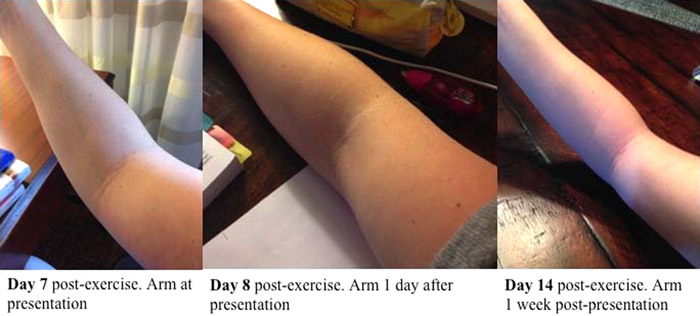Case Presentation:
A previously healthy 28‐year‐old woman presented with bilateral arm swelling. One week earlier, she had completed a high‐intensity exercise session that included 60 push‐ups, 30 shoulder presses, and 60 kettle bell swings. Within the following day, her arms were sore and weak with a limited range of motion. Seven days following the exercise, she awoke with bilateral upper extremity swelling that progressed rapidly over the course of 4 hours (Figure 1). She reported drinking 3‐4 alcoholic beverages the night immediately prior to the swelling. She was uncertain if she had any urinary changes. On initial exam, her arms were markedly edematous but only mildly tender. She had normal strength, sensation, pulses, and full range of motion at all extremities. She was mildly hypertensive and tachypneic, but vitals were otherwise unremarkable. Creatine kinase at presentation was elevated at 8,340 IU/L. Initial BMP evidenced normal serum sodium and potassium, but mildly decreased calcium (1.15 mmol/L) and bicarbonate (24 mmol/L). Initial labs also evidenced BUN 17 mg/dL and Cr 1.0 mg/dL. The patient was diagnosed with delayed onset exercise‐induced rhabdomyolysis. She was treated supportively and rapidly recovered completely (Figure 1).
Discussion:
Hospitalists are frequently asked to evaluate musculoskeletal complaints. With the increasing popularity of high‐intensity exercise programs such as Crossfit, Insanity and P90‐X, over‐use injuries are increasingly prevalent amongst otherwise healthy adults. Delayed‐onset exercise‐induced rhabdomyolysis is an uncommon but serious potential consequence of high‐intensity exercise, especially in untrained athletes. Alcohol use, over‐the‐counter supplements, viral infections, and undiagnosed metabolic abnormalities all predispose to rhabdomyolysis even in the setting of brief workouts. Subclinical myoglobinemia, myoglobinuria, and modestly elevated serum CK are common following physical exertion (up to 57% in high‐intensity exercise), and frank rhabdomyolysis occurs in 0.02% of patients. Studies on the timing of the onset of exertional rhabdomyolysis are limited, but the majority of exercise‐induced rhabdomyolysis occurs within 24 hours of the initial insult. Patients may develop severe electrolyte abnormalities and myoglobin‐induced nephropathy. In fact, 10‐50% of patients with rhabdomyolysis progress to acute renal failure, with an estimated mortality of 7‐80%. Other potential sequaelae include compartment syndrome, cardiac dysrhythmia, and disseminated intravascular coagulopathy. Interestingly, more than half of patients will not have significant muscle symptoms. Rapid identification and treatment is essential to allow affected patients to recover without serious consequences.
Conclusions:
Exercise‐induced rhabdomyolysis is an increasingly common consequence of high‐intensity workout regimens and can result in serious clinical morbidity. Unconditioned persons presenting with swelling or pain after high‐intensity exercise should be evaluated for this illness. Untrained persons should be educated about the need for caution before initiating high‐intensity short‐duration exercise regimens.

